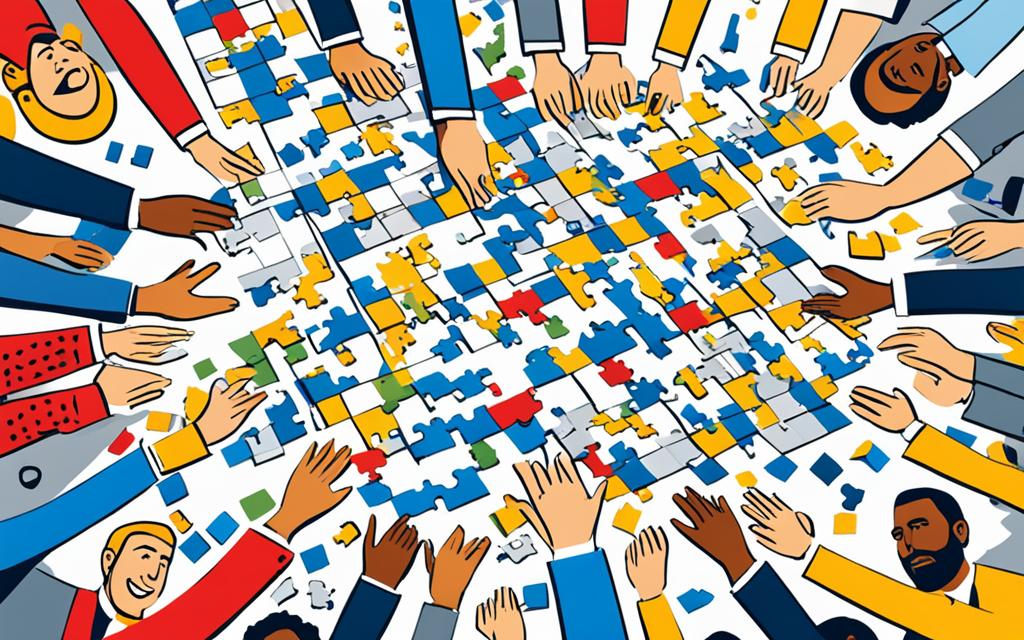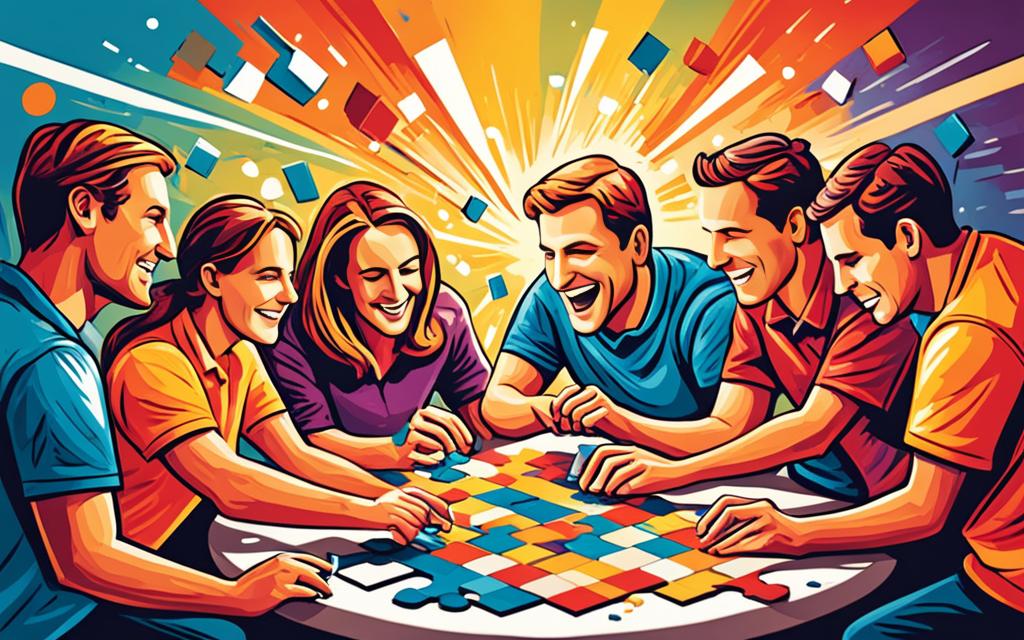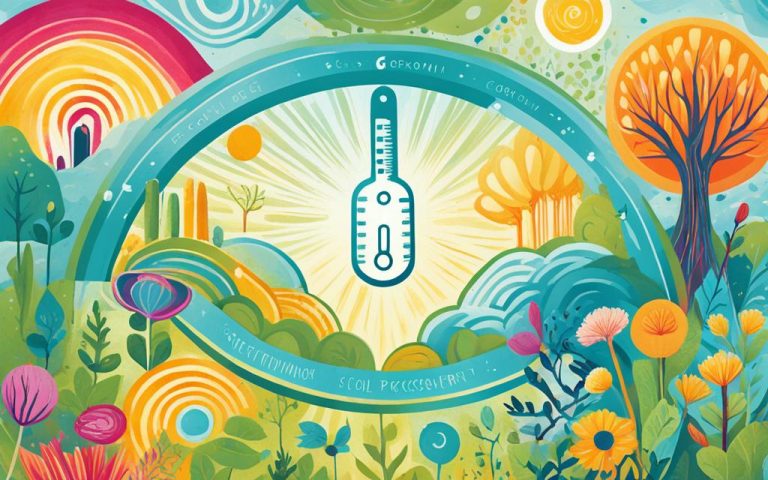Unlock Team Success with Problem Solving Activities
In the fast-paced world of work, teaming up effectively can decide an organization’s fate. It’s more than just gathering folks. It’s about merging their efforts towards creativity and greatness. Problem solving team activities play a key role here. They’re not mere games. Instead, they’re vital for your team’s progress and for boosting team performance.
Starting these interactive challenges, you’ll see a change in tackling problems. This is when ideas fly and united solutions are found. The skills mastered don’t just stay within the game. They carry over to daily tasks, making a team that’s quick and skilled in solving problems.
Diving into such teamwork exercises does more than just link your group tighter. It also readies your team for future wins, innovation, and a growing culture of improvement.
Key Takeaways
- Understand the link between team collaboration and innovative problem solving.
- Recognize problem solving team activities as a strategic tool for team enhancement.
- Learn how problem solving initiatives can result in direct application to business scenarios.
- See the benefits of integrating these activities to build a stronger, more cohesive team.
- Discover the impact of team-generated solutions on overall organizational success.
The Importance of Problem Solving in Team Dynamics
Knowing how critical problem solving is in teams helps create a place where new ideas blossom. Targeted problem solving activities tackle present issues and boost key skills in team members.
Enhancing Communication through Challenges
Problem solving tasks greatly improve effective communication in a team. In collaborative problem solving, everyone’s input is essential for finding a good solution. This requires clear expression of ideas and active listening among team members.
Building Trust with Collaborative Efforts
The core of trust building in teams comes from shared challenges and working towards a shared aim. When solving problems together, relying on each other’s abilities is a must. This journey enhances mutual respect and trust, which is key for strong team connections.
Adding problem solving to team tasks solves immediate problems and grows important social skills over time.
Top Problem Solving Team Building Activities
Playing fun team building activities is key to sparking creative problem solving in groups. We’ll look at some standout team building games known for their effectiveness. These games improve team dynamics, like communication and teamwork.
Each activity focuses on different teamwork and problem-solving skills. Your team will not only enjoy these games but also gain valuable skills for work.
- Escape Room Challenge: This pushes teams to solve puzzles together quickly. It’s great for improving decision-making under pressure.
- Cross-Function Puzzle Hunt: Teams work through puzzles to learn about each other. It promotes cross-team understanding.
- Idea Building Blocks: Teammates build on each other’s ideas to create something new. This boosts creativity and cooperation.
Let’s dive deeper into how each activity can help your team. Below is a table with their main focus and the skills they develop:
| Activity | Main Focus | Skills Developed |
|---|---|---|
| Escape Room Challenge | Pressure-driven problem solving | Critical thinking, Quick decision-making |
| Cross-Function Puzzle Hunt | Interdepartmental cooperation | Communication, Awareness of team roles |
| Idea Building Blocks | Creative synergy | Innovative thinking, Collaboration |
Top problem solving team building activities do more than just break up the daily grind. They greatly enhance your team’s creative and cooperative skills. Each game challenges teams in new ways. This helps everyone grow together and separately.
How to Facilitate Effective Team Building Exercises
To boost workplace dynamics and facilitating team building, focusing on three areas is key. These areas are: setting clear goals, efficiently guiding your teams, and making sure everyone is included and engaged. Mixing these strategies with problem-solving exercises leads to true team growth and fresh ideas.
Setting Clear Objectives
Success in team building starts with clear objectives. They give everyone a shared direction and purpose. Goals should be SMART – specific, measurable, achievable, relevant, and timely. This makes them easy to understand and act on.
Guiding Teams to Success
With guided team activities, leaders can help members tackle challenges while staying focused on goals. Good guidance means listening well, offering constant feedback, and pushing for open talks.
Ensuring Inclusion and Participation
For inclusive team exercises to work, everyone must play a part. Use varied activities that fit different people and skills, making each person feel important. Techniques like changing leaders and working together on decisions help everyone participate more and feel jointly responsible for the team’s wins.
| Strategy | Objective | Activity Example |
|---|---|---|
| Define clear goals | Align team efforts | Goal-setting workshops |
| Guide effectively | Maintain focus on tasks | Role-playing scenarios |
| Promote inclusivity | Engage all members | Team skills swap |
Innovative Problem Solving Exercises for Any Team
Whether you lead a start-up, a big company team, or a charity, using innovative team exercises helps a lot. These activities challenge your team. They also create a place for team adaptation and problem solving strategies.
Choosing different exercises is key. It ensures everyone can add value and learn. We’ll look at exercises you can tweak for your team’s needs. They boost both individual and group skills in solving problems.
- Scenario Analysis Workshops – Divide your team into smaller groups. Give them real-world problems related to their work. They must think of many ways to solve these problems. This boosts innovative thinking and teamwork.
- Reverse Brainstorming – Here, the team focuses on finding potential problems in a project. This backward approach helps in foreseeing future issues. It also aids in creating plans to tackle these challenges.
- Role Swap Exercises – Team members temporarily exchange roles in the company. This offers insights into different company areas. It encourages flexibility in solving problems.
These exercises are very adaptable. For instance, scenario analysis can be simple or complex. This depends on the team’s experience and what you want to achieve.
Including these innovative team exercises often gets your team ready for surprises. It also sharpens their problem-solving methods. Thus, no matter your team’s focus, these exercises are customizable. They make your team quicker and smarter at facing challenges.
In a world that always changes, these exercises keep your team leading in innovation. Regular practice in team adaptation and updating strategies through these activities is crucial. It ensures success and longevity in any sector.
Problem Solving Team Building Activities: A Case Study
Activities focused on problem-solving bring teams closer and improve how they work together. By studying a case closely, we see not just the perks but real growth in a team.
Analyzing Results and Feedback
After trying different problem-solving tasks, we got lots of feedback. It showed what went well and what could be better. We saw a boost in teamwork and clearer roles.
This feedback is key to making future sessions better. And it keeps enhancing how the team works together.
Measuring Team Growth Post-Activities
It’s important to measure how much a team grows after these activities. We looked at how fast projects get done, solving conflicts, and how happy the team is. We saw improvements in all these areas after the activities.
This proves that problem-solving tasks really work. And it helps plan better strategies for improvement.
The table below shows how much the team improved in different areas after the activities:
| Metrics | Before Activities | After Activities | % Improvement |
|---|---|---|---|
| Project Completion Rate | 75% | 90% | 20% |
| Conflict Resolution | Low | High | 50% |
| Team Satisfaction Level | 65% | 85% | 31% |
Each metric shows clear benefits from the training. They’re important for continued team improvement.
Designing Problem Solving Group Activities for Diverse Teams
Creating activities for your team is crucial. It’s important to focus on diverse team dynamics. Your planning should highlight inclusive group activities for all backgrounds.
Using customized problem solving strategies helps use each team member’s unique skills. Here are ways to create these essential, inclusive activities:
- Assess team members’ strengths and weaknesses through informal discussions or surveys.
- Aim to understand cultural, educational, and professional backgrounds to guide your activity planning.
- Encourage open, honest feedback to continuously refine your approach.
By valuing different views in your team, you can make exercises that are fun and effective. They help build a team spirit.
| Activity Type | Skill Targeted | Note on Inclusion |
|---|---|---|
| Role-Playing Scenarios | Communication, Negotiation | Roles designed to respect and highlight diverse backgrounds |
| Innovation Labs | Creativity, Problem Solving | Teams are mixed across departments to maximize diverse input |
| Task Swap | Adaptability, Learning | Members try different roles, understanding each other’s challenges |
These special exercises boost problem solving abilities. They also make team members value each other’s different skills and viewpoints. This drives the team towards success.
Roles and Responsibilities in Team Problem Solving
Understanding everyone’s roles and duties in a team is key to solving problems together. It shows how leadership facilitation and utilizing team member roles strengthen problem-solving efforts. This ensures everyone works well together from start to finish.
The Leader’s Role in Facilitating
Leaders are crucial for a team’s success in solving problems. They don’t just tell people what to do. Instead, they guide the team through hard times, making sure everyone is heard. Leaders recognize each person’s strengths and assign tasks wisely through leadership facilitation.
Every Member’s Contribution
But it’s not all about the leader. A team’s power also comes from each person’s input. Everyone brings something special – their ideas and abilities are key for finding new solutions. The value of team member roles lies in everyone’s unique contributions, creating a collaborative responsibility.
This image shows how leaders and team members work together. It highlights their joint effort in tackling tough problems:
| Category | Leadership Facilitation | Team Member Roles | Collaborative Responsibility |
|---|---|---|---|
| Strategic Approach | Guides focus and direction | Provides skills and insight | Integrated effort towards goal |
| Communication | Ensures clarity and understanding | Shares ideas and feedback | Open and continuous dialogue |
| Problem Identification | Frames the problem context | Identifies specifics and details | Collective agreement on issues |
| Solution Development | Encourages creative approaches | Contributes unique solutions | Mutual development and refinement |
| Result Analysis | Leads review and learning points | Provides practical insights | Shared learning experience |
The success of solving problems in a team lies in both leadership and everyone’s contributions. When both elements combine, they lead to successful projects.
Adapting Problem Solving Activities to Remote Teams
In today’s digital world, keeping teams connected and online team engagement high is tough. Yet, you can boost connection and teamwork with remote team building exercises and virtual problem solving activities.
Virtual Team Building Games that Work
Good virtual team-building games increase teamwork and cross distance hurdles. Check out these games that really help:
- Mystery Solving Adventures – Teams work to solve a mystery with digital clues.
- Virtual Escape Rooms – Teams must solve puzzles together quickly to “escape” a room online.
- Online Team Quizzes – Fun quizzes on work or trivia to spark competition and joy among team members.
Ensuring Engagement in a Remote Environment
To keep everyone active and interested in virtual activities, try these methods:
- Regular check-ins: Use regular video calls to stay in touch, allowing team members to share updates and concerns.
- Interactive tools: Pick platforms that support real-time work and play, making online teamwork fun.
- Rewards and recognition: Praise individual efforts in team tasks to lift spirits and encourage participation.
| Strategy | Tool/Activity Example | Impact |
|---|---|---|
| Collaborative platforms | Slack, Trello | Boosts live interaction and helps with organizing tasks |
| Real-time feedback | Zoom Polls, Google Forms | Helps understand engagement and knowledge levels |
Using these games and tips will keep your remote team building and virtual problem solving effective. This will keep your team’s online engagement strong and build a united team culture.
Unlocking Creativity with Problem Solving Team Activities
In today’s world, being creative in solving problems is more important than ever. By using innovative team activities, you encourage a culture of creativity and teamwork. This leads to better and quicker solutions to any challenge.
Brainstorming exercises are key to this process. They provide a way for teams to think freely and come up with solutions. Let’s look at activities that can increase creativity and improve problem-solving skills.
- Reverse Brainstorming: Instead of finding solutions, teams think of ways to cause the problem. This new perspective can open up creative ideas.
- Role Storming: Act out roles of different stakeholders or even competitors. This builds empathy and brings in fresh strategies from different viewpoints.
- Mind Mapping: Create visual maps of ideas and issues to start discussions and find new solutions.
Using these innovative team activities boosts the team’s ability to solve problems creatively. It also helps in thinking outside the box every day.
| Activity | Skills Developed | Applicability |
|---|---|---|
| Reverse Brainstorming | Critical Thinking, Creativity | Problem Identification |
| Role Storming | Empathy, Strategic Thinking | Stakeholder Analysis |
| Mind Mapping | Collaboration, Organization | Idea Development |
These activities enhance your team’s creative problem-solving skills. They create an innovative and collaborative work environment. Next time there’s a big problem, try a creative approach. It could lead to a brilliant solution.
Outdoor vs. Indoor Team Building Activities for Work
Choosing between outdoor and indoor activities can greatly shape your team’s development. Each offers unique benefits and challenges for transforming team building into an immersive experience. Knowing these differences helps in picking the right setting for your team’s goals.
Pros and Cons of Different Settings
Outdoor team building is great for energizing your team outside the office. It typically includes physical, fun, and tough tasks. These tasks help team members communicate and work together. But, they depend on good weather and need more planning.
Indoor problem solving offers a predictable place for creative and strategic activities. It’s ideal for focus but lacks the physical aspect of outdoor activities. This can be a minus for teams looking for dynamic interaction.
Creating an Immersive Experience
Creating an immersive team experience is about more than location. It includes the activity design, tools, and scenario set-up. This engages every team member fully. Understanding your team’s goals and makeup helps make an experience that connects with everyone.
| Activity Type | Benefits | Challenges |
|---|---|---|
| Outdoor Team Building | Enhances communication, boosts morale, provides physical activity | Weather-dependent, requires significant space |
| Indoor Problem Solving | Enhances focus, fosters creativity, not weather dependent | Limited physical activity, can feel like an extension of office work |
In conclusion, the success of team building depends on using outdoor freshness or indoor focus. The right activities, tailored to your team’s needs, make every session effective and memorable.
Fun Team Building Activities That Promote Problem Solving
Corporate team building that is fun can make skill-building exciting. It engages your staff and boosts their problem-solving skills in a memorable way. Add enjoyable learning activities and games to make training sessions lively and insightful.
Making Learning Enjoyable
For effective and fun problem-solving, look beyond usual workshops. Consider games that improve strategic thinking and teamwork. Turn real-world challenges into exciting games. This makes learning enjoyable and shows how to apply these skills in real situations.
Games That Teach Valuable Skills
A few educational games are great for building problem-solving skills. These games are fun, need minimal setup, and blend learning with fun. They’re ideal for any team wanting to learn while having a good time.
| Game Name | Skill Focus | Duration | Players |
|---|---|---|---|
| Escape Room Challenge | Critical Thinking, Teamwork | 60 mins | 4-8 per room |
| Treasure Hunt | Resource Management, Strategic Planning | 30-45 mins | Small groups |
| Bridge Building | Innovation, Project Management | 45 mins | Teams of 3-5 |
These games aim to make learning fun. They focus on important skills like strategy, leadership, and communication. Include these games in your next team-building event for more excitement and better teamwork.
Customizing Problem Solving Exercises to Fit Your Team
Adapting and creating tailored team exercises is key for boosting your team’s success and motivation. Teams vary in dynamics and issues, making it important to customize problem solving appropriately.

Start by evaluating your team’s needs and strengths. This helps you develop personalized problem solving strategies that click with your team. Consider things like team size, individual abilities, and desired outcomes.
- Evaluate the current proficiency levels in problem solving within your team.
- Identify the main obstacles that hinder effective collaboration among team members.
- Understand the individual and collective learning styles of your team.
Understanding these points lets you tailor activities. These activities should not only target weaknesses but also leverage strengths.
| Factor | Customization Strategy | Expected Outcome |
|---|---|---|
| Team Size | Adjust task complexity and roles to ensure inclusive participation. | Enhanced collaboration and reduced feelings of overcrowding or neglect. |
| Varied Skill Levels | Design tiered problem-solving challenges that cater to different skill levels. | Increased engagement and personal growth opportunities. |
| Communication Styles | Integrate communication exercises that cater to both verbal and non-verbal communicators. | Improved mutual understanding and efficiency in problem solving. |
Tailored team exercises improve your team’s problem-solving skills and lead to a united, driven team. The aim of personalized problem solving is to foster a supportive space. This space helps each team member flourish and contribute fully.
The Role of Feedback in Team Bonding Games
Feedback is vital in team bonding. It directs growth, collaboration, and communication. It turns problem-solving games into more than just fun. Creating a space where everyone can share their thoughts is key.
Giving and receiving feedback makes the learning better. It helps team members think about how they interact. It also helps them find ways to do better next time.
Facilitating Constructive Criticism
We need an open space for constructive criticism in team games. This lets everyone share their ideas in a positive way. It’s important because it shows every opinion matters.
How feedback is given affects how it’s taken. A respectful environment helps everyone feel valued. Teaching how to give constructive feedback helps the team grow together.
Using Feedback to Improve Future Activities
After an activity, ask for feedback. This helps figure out what works and what doesn’t. It also lets you know what to try next time.
Using this feedback makes your games better. It shows you’re committed to making team bonding better. This leads to a team that’s more together, creative, and strong.
FAQ
What are some effective problem solving team building activities?
Effective problem solving team building activities include escape room challenges and simulation games. Scavenger hunts and collaborative puzzles are also great. These activities boost teamwork, enhance communication, and help develop problem-solving skills in a group.
How do problem solving activities enhance team performance?
Problem solving activities boost team collaboration, communication, and trust. Teams learn to use each other’s strengths and ideas. This leads to innovation and better performance at work.
Can problem solving games improve communication within a team?
Yes, problem solving games can greatly enhance communication in a team. They provide a space for members to share ideas, listen, and collaborate on solutions.
What role does trust play in problem solving exercises?
Trust is crucial in problem solving exercises. Team members need to rely on each other for decisions and shared goals. Trust-building activities create a stronger, more effective team.
What are the keys to facilitating successful team building exercises?
To lead successful team building exercises, it’s key to have clear objectives. Guiding teams and ensuring everyone participates actively is also important.
Why is it important to have diverse team problem solving activities?
Diverse problem solving activities are key because they suit various skills and cultural views. This leads to creative solutions and a more inclusive environment.
How should a leader act during team problem solving activities?
A leader should guide and support the team during problem solving activities. They should encourage members to share their ideas and solutions.
Are virtual team building games effective for remote teams?
Yes, virtual team building games work well for remote teams. They keep members engaged, build rapport, and create a community feeling, even from afar.
How can problem solving activities unlock creativity in a team?
Problem solving activities prompt creativity by encouraging out-of-the-box thinking. Through brainstorming and innovative games, teams can find dynamic ways to think creatively.
What factors should be considered when customizing problem solving exercises for a team?
When customizing activities, consider the team’s size and members’ strengths. Also, think about communication styles and any industry-specific challenges.
How does feedback play a role in team bonding games?
Feedback in team bonding games offers valuable insights. It shows what was successful and what can be better. This supports improvement and learning in future activities.







